Intel NUC 12 Pro Wall Street Canyon Kits Review: Alder Lake in UCFF Avatar
by Ganesh T S on January 26, 2023 11:30 AM ESTSystem Performance: Multi-Tasking
One of the key drivers of advancments in computing systems is multi-tasking. On mobile devices, this is quite lightweight - cases such as background email checks while the user is playing a mobile game are quite common. Towards optimizing user experience in those types of scenarios, mobile SoC manufacturers started integrating heterogenous CPU cores - some with high performance for demanding workloads, while others were frugal in terms of both power consumption / die area and performance. This trend is now slowly making its way into the desktop PC space.
Multi-tasking in typical PC usage is much more demanding compared to phones and tablets. Desktop OSes allow users to launch and utilize a large number of demanding programs simultaneously. Responsiveness is dictated largely by the OS scheduler allowing different tasks to move to the background. Intel's Alder Lake processors work closely with the Windows 11 thread scheduler to optimize performance in these cases. Keeping these aspects in mind, the evaluation of multi-tasking performance is an interesting subject to tackle.
We have augmented our systems benchmarking suite to quantitatively analyze the multi-tasking performance of various platforms. The evaluation involves triggering a ffmpeg transcoding task to transform 1716 3840x1714 frames encoded as a 24fps AVC video (Blender Project's 'Tears of Steel' 4K version) into a 1080p HEVC version in a loop. The transcoding rate is monitored continuously. One complete transcoding pass is allowed to complete before starting the first multi-tasking workload - the PCMark 10 Extended bench suite. A comparative view of the PCMark 10 scores for various scenarios is presented in the graphs below. Also available for concurrent viewing are scores in the normal case where the benchmark was processed without any concurrent load, and a graph presenting the loss in performance.
| UL PCMark 10 Load Testing - Digital Content Creation Scores | |||
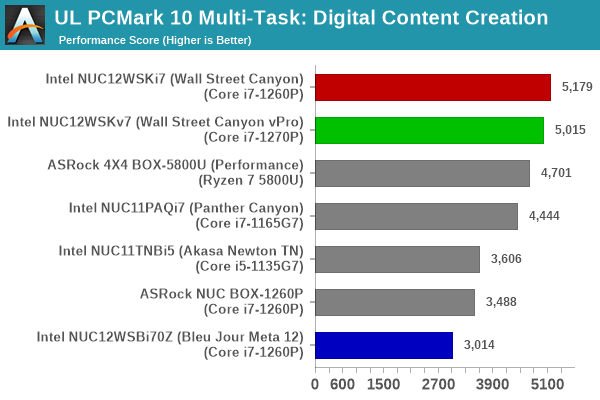
| UL PCMark 10 Load Testing - Productivity Scores | |||
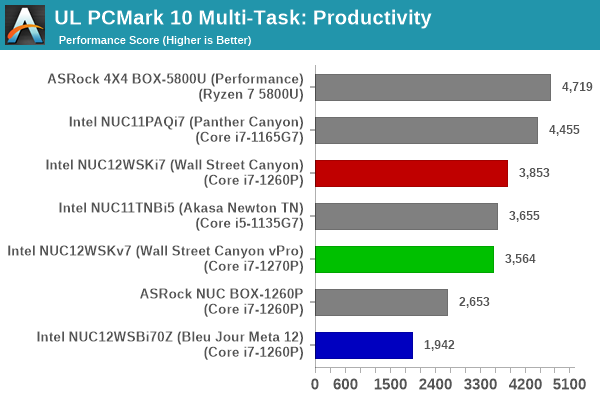
| UL PCMark 10 Load Testing - Essentials Scores | |||
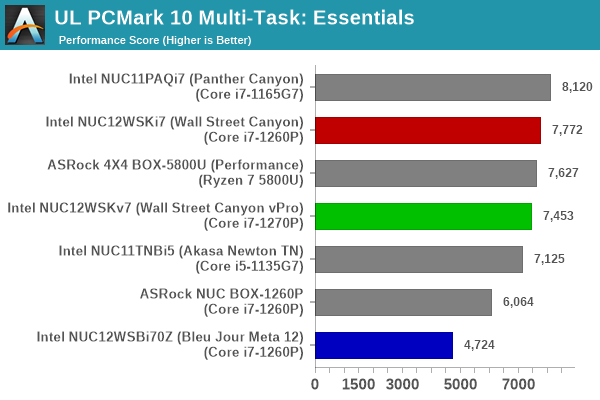
| UL PCMark 10 Load Testing - Gaming Scores | |||
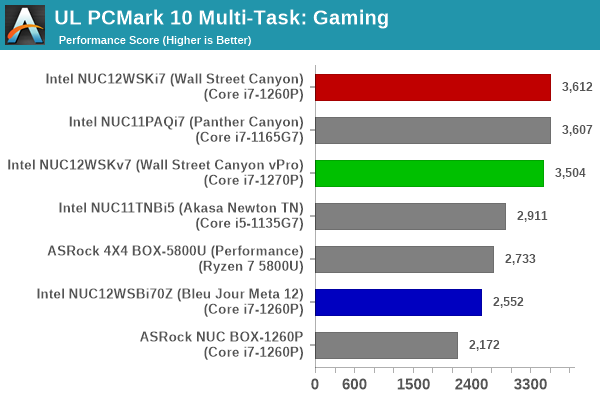
| UL PCMark 10 Load Testing - Overall Scores | |||
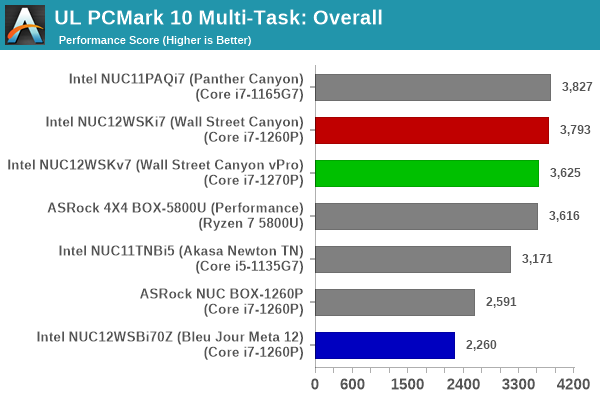
The NUC 12 Pro kits manage to keep the same performance lead irrespective of the presence of the transcoding load.
Following the completion of the PCMark 10 benchmark, a short delay is introduced prior to the processing of Principled Technologies WebXPRT4 on MS Edge. Similar to the PCMark 10 results presentation, the graph below show the scores recorded with the transcoding load active. Available for comparison are the dedicated CPU power scores and a measure of the performance loss.
| Principled Technologies WebXPRT4 Load Testing Scores (MS Edge) | |||
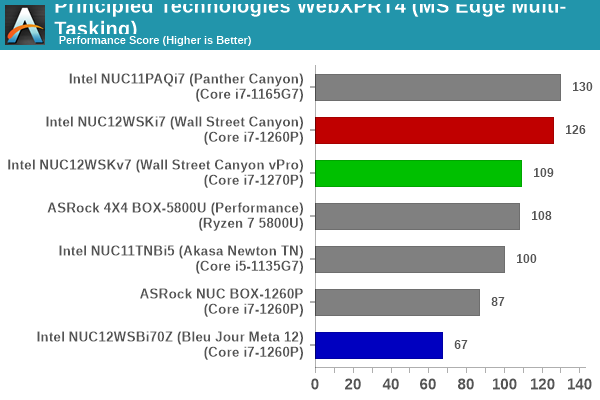
The final workload tested as part of the multitasking evaluation routine is CINEBENCH R23.
| 3D Rendering - CINEBENCH R23 Load Testing - Single Thread Score | |||
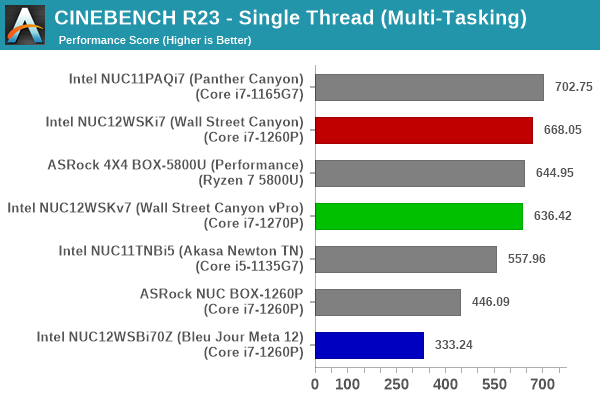
| 3D Rendering - CINEBENCH R23 Load Testing - Multiple Thread Score | |||

The Alder Lake systems manage to maintain acceptable performance levels despite the presence of additional loading. Even in the cases where the percentage drop is high, the absolute performance number still manages to be better.
After the completion of all the workloads, we let the transcoding routine run to completion. The monitored transcoding rate throughout the above evaluation routine (in terms of frames per second) is graphed below for all three NUC 12 Pro kits.
| ffmpeg Transcoding Rate and Processor Usage | |||
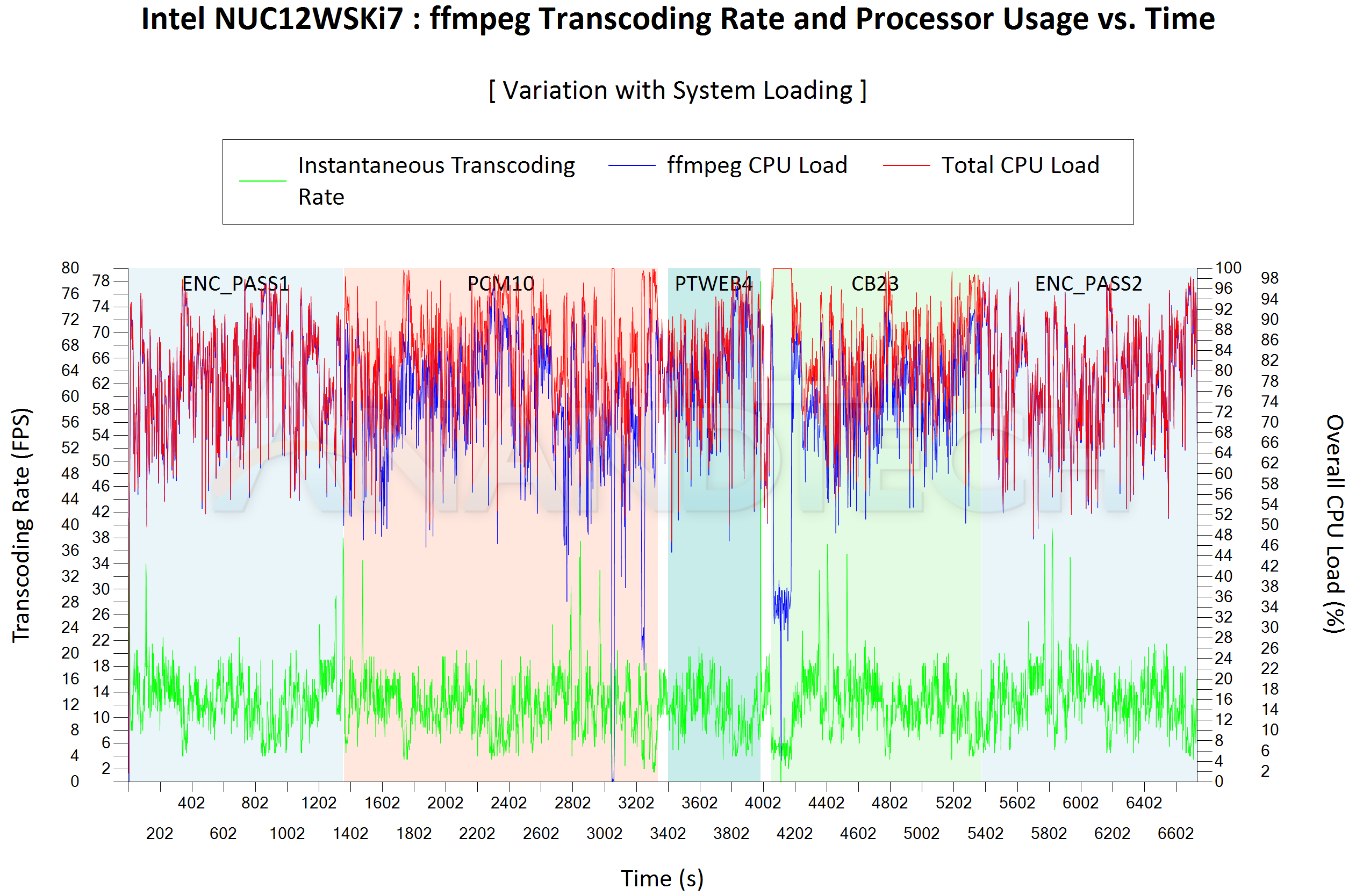
| Intel NUC12WSKi7 ffmpeg Transcoding Rate (Multi-Tasking Test) | |||
| Task Segment | Transcoding Rate (FPS) | ||
| Minimum | Average | Maximum | |
| Transcode Start Pass | 4 | 13.03 | 40.5 |
| PCMark 10 | 0 | 11.53 | 37.5 |
| WebXPRT 4 | 3.5 | 11.1 | 21 |
| Cinebench R23 | 0 | 11.78 | 37 |
| Transcode End Pass | 3.5 | 12.96 | 39.5 |
| Intel NUC12WSKv7 ffmpeg Transcoding Rate (Multi-Tasking Test) | |||
| Task Segment | Transcoding Rate (FPS) | ||
| Minimum | Average | Maximum | |
| Transcode Start Pass | 4 | 12.55 | 42 |
| PCMark 10 | 0 | 11.12 | 35.5 |
| WebXPRT 4 | 3 | 10.58 | 21 |
| Cinebench R23 | 2 | 11.48 | 35 |
| Transcode End Pass | 3.5 | 12.4 | 38.5 |
| Intel NUC12WSBi70Z (Bleu Jour Meta 12) ffmpeg Transcoding Rate (Multi-Tasking Test) | |||
| Task Segment | Transcoding Rate (FPS) | ||
| Minimum | Average | Maximum | |
| Transcode Start Pass | 1.5 | 7.94 | 31.5 |
| PCMark 10 | 0 | 5.88 | 21.5 |
| WebXPRT 4 | 0 | 6.48 | 13.5 |
| Cinebench R23 | 0 | 5.94 | 23.5 |
| Transcode End Pass | 1 | 6.52 | 24 |
The NUC12WSKi7 kit with the Core i7-1260P performs the best in terms of raw numbers, but the Core i7-1270P has a lower loss in transcoding performance with additional loads in the picture. The Bleu Jour Meta 12 is heavily throttled and doesn't come anywhere near the performance numbers of the other two systems.










25 Comments
View All Comments
abufrejoval - Sunday, January 29, 2023 - link
In the PC market, even "small" niches seem to be big enough to merit a product, otherwise Intel wouldn't keep on doing them.My main NUC use case is µ-servers in a 10Gbit cluster using cheap cascaded KVMs in the rare case I need the console. Near silent and low average power 24x7 operation is the goal, with enough peak power to get things done in a hurry.
Yes, you could build that from laptops, but unfortunately the ones that offer 64GB RAM and 2-8TB of NVMe as well as a TB port for 10GBit Ethernet are designed for gamers and carry quite a hefty premium and extras I don't need.
In corporate workplaces laptops have pretty much replaced small form factor PCs, even more so with the pandemic. But there are still quite a lot of profesisonal installations in public services, medical care and production, where NUCs mounted to a firmly attached display are quite the ticket.
Personally, I'd prefer to have Mini-ITX board variants for every NUC Intel builds, but that really seems too niche these days.
ottonis - Friday, March 17, 2023 - link
A NUC can be a tremedously useful device to power up a basic digital audio workstation (DAW), alongside external audio and midi devices. It has enough processing power to run even the most modern DAW (e.g. studio one) alongside a bunch of virtual instruments and effects. Once everything is installed and up and running, it may be useful to deactivate Wifi, Bluetooth and LAN and to purge the autostart menu from all but the most essential scripts and programs, in order to reduce DPC latency.It is so compact that it a dream come true for musicians wanting to save precious space in the homerecording studios or who are on the run and on tour and need to travel as light as possible.
So, if you know how to set this device up, it is an invaluable tool for musicians.
It's benefit over laptops: it has more I/O. I struggled to connect all my external devices with an otherwise great laptop, but the NUC can handle them all (4x USB-A + 2x USB-C)
CyrIng - Saturday, January 28, 2023 - link
The blue carton box has a better look than the NUC case.About Hybrid processors, CoreFreq is now monitoring Pcore and Ecore, including their own Turbo tunable tweaks
ISO available at www.cyring.fr
abufrejoval - Sunday, January 29, 2023 - link
The GPU-Z data is obviously bollocks: I was first thrown off by the low memory bandwidth of 25GB/s, which is really what DDR3 based GT3 solutions or single channel DDR4 might do (64-bit width may be another hint, because it's 128-bit on dual channel).I am seeing more like 40GB/s on my various Xe's, 38.4GB/s on an i7-1165G7 and 42GB/s on an i5-12500H with an 80EU Xe, both using DDR4-3200 SO-DIMMs.
But it's the pixel and texture fill rates and the GPU boost clocks where things must have been read wrong, nothing clocks 11GHz on CMOS just yet and the fill rates are matching the RTX2060 on my NUC11PHBi7 using GDDR6, 10GPixels and 21 GTexels are more realistic with 1.3GHz boost.
So please recheck the setup and data.
abufrejoval - Sunday, January 29, 2023 - link
It's too bad how Intel often just manages to get withini >90% of what I want, only to bungle it on the final stretch...The "blue day meta" variants (what on Earth did they smoke?) are rather intriguing because they seem to allow screwing say a Noctua fan on top (is there a matching fan connector on the board?): that could fix the major isse with the NUCs, too little volume/mass for cooling 20-30 Watts at acceptable noise levels.
What's critically missing for me, is the Thunderbolt ports, which I need for 10GBit networking, be it via Ethernet or TCP over TB. I believe those parts may still be in short supply, but I'd always pay €20-30 extra to have those ports.